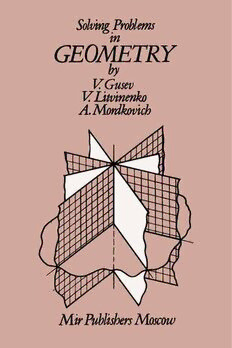
Solving Problems In Geometry PDF
Preview Solving Problems In Geometry
SOLVING PROBLEMS IN GEOMETRY B. A. TyceB B. H. JIUTBUHeHKO A. T. Mop^KOBUI nPAKTHKYM no PEniEHHIO MATEMATHHECKHX 3AflAn reOM6TpHH Ji3AaiejibCTBo «IlpocBemeHHe)> MOGKBA Solving Problems in GEOMETRY by V Gusev VLitvinenko A.Mordkovich Mir Publishers Moscow Translated from Russian by Leonid Levant First published 1988 Revised from the 1985 Russian edition Ha OH2JIUUCKOM H3blKe Printed in the Union of Soviet Socialist Republics © M3flaTejibCTBO «ripocBeu|eHue», 1985 ISBN 5-03-000499-8 © English translation, Mir Publishers, 1988 PREFACE 'This hook is intended for students at pedagogical (teacher training) institutes majoring in mathematics or in mathematics and physics. It lias been written in correspondence with the current syllabus “Solv ing Problems”. When preparing the text, we wanted to represent the main types of problems in geometry found at school. The book contains about 1000 problems that, should be solved independently. Alongside rather simple problems, there are problems whose solution requires pro found meditation and sometimes even a nonstandard approach. The solution of most of the problems in this book will help the student form the professional habits important for a future teacher of mathe matics, that is, to know how to solve the geometrical problems cov ered by the mathematics syllabus for high schools and vocational schools. Various techniques and methods of solving geometrical problems are dealt with in the geometry courses at pedagogical institutes. How ever, not enough time is dedicated to the traditional methods of solution. To bridge this gap was one of the aims of our study aid. We should like to emphasize that this book is not only a collection of problems, it is also a workbook in solving problems. This influ ences the contents and structure of the book itself. Each section contains relevant theoretical material and detailed worked examples. We were especially careful when choosing the worked examples so that each solution will be helpful for the stu dent, first from the methodological viewpoint, and so that the col lection of these examples be ample and complete. Almost each of the sixteen sections has problems for the student to solve without assistance. They are grouped according to the sections and subsec tions of school geometry and in order of increasing difficulty. Most of the problems for independent solution are supplied with answers at the end of the book, a considerable number of problems have hints for their solution. The present study aid consists of two chapters. Chapter 1 (Secs. 1-7) deals with planlmetric problems, Sec. 1 being very important as it is, in a way, an introduction to the entire book. It discusses the methods for solving traditional geometrical problems, which will 6 Preface later be frequently used. Pure geometrical, algebraic, and combined methods are considered together with special cases, the method of a reference element (including the method of areas) and the method of an auxiliary parameter. To make the use of the book more con venient, this introductory section lists the important theorems of plane geometry, which should facilitate the solution of problems. Sections 2 to 4 contain many standard problems of average dif ficulty, since experience shows that traditional planimetric problems are one of the weakest points in the preparation of future teachers of mathematics. The main aim of Secs. 5 and 6 is to supply the student with the necessary habits and “know-how” for solving geometrical problems using the method of geometrical transformations and the vector method. We should like to underline here that these sections con tain, as a rule, traditional geometrical problems to be solved by the indicated methods, but not the special problems on transformations and vectors that are frequently encountered in collections of prob lems in geometry. Since geometrical problems can be solved by differ ent methods, the student will sometimes meet identical or similar problems in Secs. 2 to 4 and 5 to 6. Two sections (7 and 16) are dedicated to the geometrical problems on finding the greatest and least values. These problems are usually thought to be a part of mathematical analysis, but in the latter the main purpose of these problems is to demonstrate the application of differential calculus (that is, the accent is on solving a problem with in the framework of a mathematical model and, to a lesser extent, on setting up a model and interpreting it). When we included in this book problems for finding the greatest and least values, we were concerned that each problem should be interesting first from the geometrical viewpoint (that is, the accent was on the construction of a mathematical model and its interpretation). Chapter 2 deals with stereometric problems. Questions on the construction of the representation of a given solid, and the deter mination of the completeness of the representation and its metric determinacy are posed in a concise form. Consideration is given to geometrical construction in space, particular attention being paid to constructions on representations. Most of the problems in both chap ters were specially devised for this study aid. Among them, we should like to mention the determination of the angle between skew lines, the distance between them, the angle between a straight line and a plane, dihedral angles, and the construction of sections. In our opinion, solving these problems will help the student develop the ability of three-dimensional visualization. The structure and contents of the book, the ways of setting forth the material, and the choice and arrangement of the problems were done by the authors collectively. The material for Secs. 1-4, 7 and
